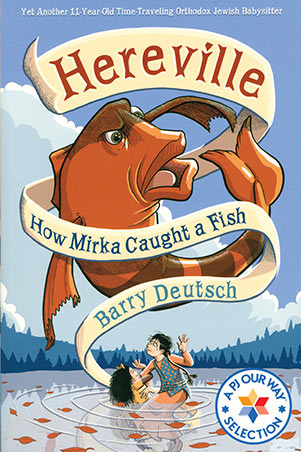Hereville: How Mirka Caught a Fish
Mirka’s back! Can she defeat the magic fish and save her family? Is she the absolute worst babysitter ever? A wild new adventure starring our favorite time-traveling, troll-fighting, Orthodox Jewish heroine!
Average Rating
( hint: Login to leave a review! )
308 Reviews
Leave Review
What the Book is About
Jewish Content & Values
Positive Role Models
Content Advisory
Talk it Over!
More for You
What the Book is About
This offbeat graphic novel (third in the trilogy that includes Hereville: How Mirka Got her Sword and Hereville: How Mirka Met a Meteorite) is set in a fictitious Jewish shtetl (a small Eastern European Jewish village) called Hereville. The heroine, Mirka, is not your typical eleven-year-old Orthodox Jewish shtetl girl. She dreams of becoming a hero and slaying monsters, so she’s decidedly not enthused to be babysitting her little sister, Layele. Mirka’s thirst for adventure gets her in over her head as she fights a vengeful magic fish and discovers what is most precious to her.
Jewish Content & Values
- Hereville is a fictional shtetl. Full-color drawings depict girls and boys in traditional Orthodox garb classic to the shtetl era, and colorful Yiddish words (translated in footnotes) are used throughout.
- Mirka and her family celebrate Shabbos (Yiddish for Shabbat – the Jewish day of rest). This is an important spiritual time for Mirka and her stepmother to put aside their fears and gain strength to fight against the magic fish.
- Tzar Baalei Chayim (suffering of living things) refers to the Jewish Talmudic principle that forbids causing unnecessary pain to animals. Mirka decides that burying the magical fish alive to protect future generations is not the way to be a kind and responsible Jew, so she convinces her stepmother and sister to find another solution.
Positive Role Models
- Mirka is a fun character with lots of personality. Her impulsivity and passion often get her into trouble, but she has a good-natured, introspective side and cares deeply about doing the right thing.
- Fruma, Mirka’s stepmother, protects and loves Mirka as a mother would. Although some might argue that the potentially life-threatening circumstances of the plot warranted desecration of Shabbat, she nevertheless demonstrates tremendous commitment to tradition as she celebrates Shabbat under trying circumstances.
Content Advisory
There’s some light comic-book style violence (Smack/Bam/Pow/Ouch) as well as a few insults like “stupid.” The idea of Mirka’s sister Layele being kidnapped underwater by the fish could be frightening to some kids.
Talk It Over!
Because the fish gains strength with every attempt to hurt her, Mirka actually fights the fish successfully by not fighting the fish. Do you think that this method could be used in a real fight between two friends? What are some methods you’ve used successfully to end a fight?
More for You
Gefilte fish is a classic Ashkenazi appetizer eaten on Shabbat. The dish is consists of ground fish, spices, eggs, and bread crumbs or matzo meal mixed into a paste, rolled into patties, and then poached in a fish broth. It is traditionally served with a sliced cooked carrot on top and beet-flavored horseradish (chrane) on the side. Cooking fish in this manner could stretch a bit of ground fish into enough food to feed the whole family. Furthermore, religiously observant Jews served this dish to avoid the prohibited activity of borer (choosing) on Shabbat; eating gefilte fish circumvented the necessity of picking out the bones from the flesh. Gefilte fish may be sweet or peppery, and the taste often revealed the eastern European origins of the chef: Polish/Galician Jews traditionally opted for the sweet version, while Lithuanians were fans of the savory dish.
What the Book is About
What the Book is About
This offbeat graphic novel (third in the trilogy that includes Hereville: How Mirka Got her Sword and Hereville: How Mirka Met a Meteorite) is set in a fictitious Jewish shtetl (a small Eastern European Jewish village) called Hereville. The heroine, Mirka, is not your typical eleven-year-old Orthodox Jewish shtetl girl. She dreams of becoming a hero and slaying monsters, so she’s decidedly not enthused to be babysitting her little sister, Layele. Mirka’s thirst for adventure gets her in over her head as she fights a vengeful magic fish and discovers what is most precious to her.
Jewish Content & Values
Jewish Content & Values
- Hereville is a fictional shtetl. Full-color drawings depict girls and boys in traditional Orthodox garb classic to the shtetl era, and colorful Yiddish words (translated in footnotes) are used throughout.
- Mirka and her family celebrate Shabbos (Yiddish for Shabbat – the Jewish day of rest). This is an important spiritual time for Mirka and her stepmother to put aside their fears and gain strength to fight against the magic fish.
- Tzar Baalei Chayim (suffering of living things) refers to the Jewish Talmudic principle that forbids causing unnecessary pain to animals. Mirka decides that burying the magical fish alive to protect future generations is not the way to be a kind and responsible Jew, so she convinces her stepmother and sister to find another solution.
Positive Role Models
Positive Role Models
- Mirka is a fun character with lots of personality. Her impulsivity and passion often get her into trouble, but she has a good-natured, introspective side and cares deeply about doing the right thing.
- Fruma, Mirka’s stepmother, protects and loves Mirka as a mother would. Although some might argue that the potentially life-threatening circumstances of the plot warranted desecration of Shabbat, she nevertheless demonstrates tremendous commitment to tradition as she celebrates Shabbat under trying circumstances.
Content Advisory
Content Advisory
There’s some light comic-book style violence (Smack/Bam/Pow/Ouch) as well as a few insults like “stupid.” The idea of Mirka’s sister Layele being kidnapped underwater by the fish could be frightening to some kids.
Talk it Over!
Talk It Over!
Because the fish gains strength with every attempt to hurt her, Mirka actually fights the fish successfully by not fighting the fish. Do you think that this method could be used in a real fight between two friends? What are some methods you’ve used successfully to end a fight?
More for You
More for You
Gefilte fish is a classic Ashkenazi appetizer eaten on Shabbat. The dish is consists of ground fish, spices, eggs, and bread crumbs or matzo meal mixed into a paste, rolled into patties, and then poached in a fish broth. It is traditionally served with a sliced cooked carrot on top and beet-flavored horseradish (chrane) on the side. Cooking fish in this manner could stretch a bit of ground fish into enough food to feed the whole family. Furthermore, religiously observant Jews served this dish to avoid the prohibited activity of borer (choosing) on Shabbat; eating gefilte fish circumvented the necessity of picking out the bones from the flesh. Gefilte fish may be sweet or peppery, and the taste often revealed the eastern European origins of the chef: Polish/Galician Jews traditionally opted for the sweet version, while Lithuanians were fans of the savory dish.

